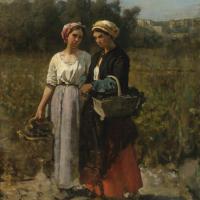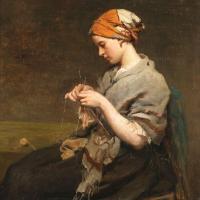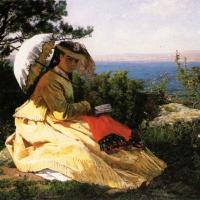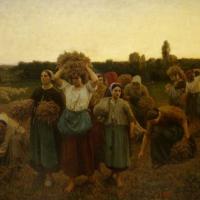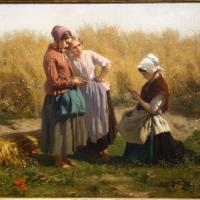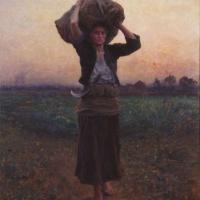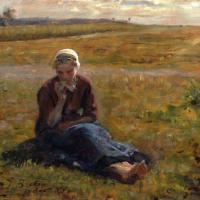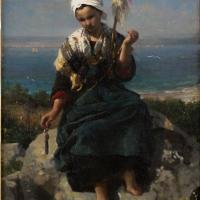Jules Breton
Cueilleuse De Figues
$480.00
Jeune Fille Tricotant
$480.00
La Femme A L Ombrelle
$480.00
Le Rappel Des Glaneuses
$480.00
Love Tokens
$480.00
Shepherd S Star
$480.00
Study For The Snack
$480.00
The Flax Spinner
$480.00
The Weeders
$480.00
Washerwoman In Brittany
$480.00
Jules Breton
Jules Adolphe Aimé Louis Breton (1 May 1827 – 5 July 1906) was a 19th-century French Realist painter. His paintings are heavily influenced by the French countryside and his absorption of traditional methods of painting helped make Jules Breton one of the primary transmitters of the beauty and idyllic vision of rural existence.

Breton was born on 1 May 1827 in Courrières, a small Pas-de-Calais village. His first artistic training was not far from Courrières at the College St. Bertin near Saint-Omer. He met the painter Félix De Vigne in 1842 who, impressed by his youthful talent, persuaded his family to let him study art. Breton left for Ghent in 1843 where he continued to study art at the Academy of Fine Artswith de Vigne and the painter Hendrik Van der Haert. In 1846, Breton moved to Antwerp where he took lessons with Egide Charles Gustave Wappers and spent some time copying the works of Flemish masters. In 1847, he left for Paris where he hoped to perfect his artistic training at the École des Beaux-Arts.
In Paris he studied in the atelier of the Michel Martin Drolling. He met and became friends with several of the Realist painters, including François Bonvin and Gustave Brion and his early entries at the Paris Salon reflected their influence. His first efforts were in historical subjects: Saint Piat preaching in Gaul then, under the influence of the revolution of 1848, he represented Misery and Despair. The Salon displayed his painting Misery and Despair in 1849 and Hunger in 1850-51. Both paintings have since been destroyed. After Hunger was successfully shown in Brussels and Ghent, Breton moved to Belgium where he met his future wife Elodie.
He continued to exhibit throughout the 1870s and into the 1880s and 1890s and his reputation grew. His poetic renderings of single peasant female figures in a landscape, posed against the setting sun, remained very popular, especially in the United States. Since his works were so popular, Breton often produced copies of some of his images. He was extremely popular in his own time, exhibiting numerous compositions at the Salons that were widely available as engravings. He was one of the best known painters of his period in his native France as well as England and the United States. In 1880 Vincent van Gogh walked 85 miles to Courrières to pay a visit to Breton, whom he greatly admired, but turned back, put off by Breton's high wall.
In 1886, Breton was elected a member of the Institut de France on the death of Baudry. In 1889 he was made commander of the Legion of Honor, and in 1899 foreign member of the Royal Academy of London. His brother Emile, an architect by training, and his daughter Virginie were also painters.
He also wrote several books, and was a recognized writer who published a volume of poems (Jeanne) and several editions of prose relating his life as an artist and the lives of other artists that he personally knew; among them Les Champs et la mer (1876), Nos peintres du siècle(1900), Delphine Bernard (1902), and La Peinture (1904). Breton died in Paris on 5 July 1906. His numerous subjects may be divided generally into four classes: labour, rest, rural festivals and religious festivals.
Willa Cather's novel The Song of the Lark takes its name from Breton's painting.
In 1912, Jules Breton St. in the 13th arrondissement of Paris was given his name.
In February 2014, actor Bill Murray disclosed at a press event for the film, "The Monuments Men," that an encounter with Breton's painting "The Song of the Lark," at the Art Institute of Chicago, helped turn him away from suicidal (or perhaps just plain "sad") thoughts.



